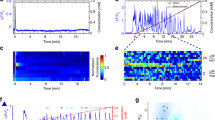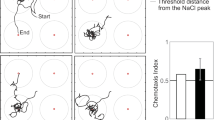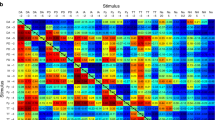Abstract
We derive a linear neural network model of the chemotaxis control circuit in the nematode Caenorhabditis elegans and demonstrate that this model is capable of producing nematodelike chemotaxis. By expanding the analytic solution for the network output in time-derivatives of the network input, we extract simple computational rules that reveal how the model network controls chemotaxis. Based on these rules we find that optimized linear networks typically control chemotaxis by computing the first time-derivative of the chemical concentration and modulating the body turning rate in response to this derivative. We argue that this is consistent with behavioral studies and a plausible mechanism for at least one component of chemotaxis in real nematodes.
Similar content being viewed by others
References
Bargmann CI, Horvitz HR (1991) Chemosensory neurons with overlapping functions direct chemotaxis to multiple chemicals in C. Elegans. Neuron 7:729–742.
Beer RD, Gallagher JC (1992) Evolving dynamical neural networks for adaptive behavior. Adaptive Behavior 1(1):91–122.
Berg HC, Brown DA (1972) Chemotaxis in Escherichia coli analyzed by three-dimensional tracking. Nature 239:500–504.
Boyce WE, DiPrima RC (1977) Elementary Differential Equations and Boundary Value Problems. Wiley, New York.
Davis RE, Stretton AOW (1989) Signaling properties of Ascaris motor neurons: Graded active responses, graded synaptic transmission, and tonic transmitter release. J. Neurosci. 9:415–425.
Dunn GA (1990) Conceptual problems with kinesis and taxis. In: JP Armitage, Lackie JM, eds. Biology of the Chemotactic Response. Cambridge University Press, Cambridge, MA. pp. 1–13.
Dusenbery DB (1976) Chemotactic behavior of mutants of the nematode C. elegans that are defective in their attraction to NaCl. J. Exp. Zool. 198:343–352.
Dusenbery DB (1980) Responses of the nematode Caenorhabditis elegans to controlled chemical stimulation. J. Comp. Physiol. A 136:327–331.
Epstein HF, Isachsen MM, Suddleson EA (1976) Kinetics of movement of normal and mutant nematodes. J. Comp. Physiol. 110:317–322.
Ferrée TC, Lockery SR (1998) Chemotaxis control by linear recurrent networks. In: J Bower, ed. Computational Neuroscience: Trends in Research. Plenum Press, New York, pp. 373–377.
Ferrée TC, MArcotte BA, Lockery SR (1997) Neural network models of chemotaxis in the nematode Caenorhabditis elegans. In: MC Mozer, MI Jordan, T Petsche, eds. Advances in Neural Information Processing Systems 9. MIT Press, Cambridge, MA. pp. 55–61.
Fraenkel GS, Gunn DL (1940, revised 1961) The Orientation of Animals: Kineses, Taxes and Compass Reactions. Dover Press, New York.
Goodman MB, Hall DH, Avery L, Lockery SR (1998) Active currents regulate sensitivity and dynamic range in C. elegans neurons. Neuron 20:763–722.
Green CD (1976) Simulation of nematode attraction to a point in a flat field. Behaviour 61:130–146.
Hedgecock EM, Russell RL (1975) Normal and mutant thermotaxis in the nematode Caenorhabditis elegans. Proc. Natl. Acad. Sci. 72:4061–4065.
Lewis JA, Hodgkin JA (1977) Specific neuroanatomical changes in chemosensory mutants of the nematode C. elegans. J. Comp. Neurol. 172:489–510.
Masters T (1995) Advanced Algorithms for Neural Networks: A C++ Sourcebook. Wiley, New York.
Morales B, Ugarte G, Labarca P, Bacigalupo J (1994) Inhibitory KC current activated by odorants in toad olfactory neurons. Proc. R. Soc. Lond. 257:235–242.
Niebur E, Erdös P (1991) Theory of the locomotion of nematodes: Dynamics of undulatory progression on a surface. Biophys. J. 60:1132–1146.
Niebur E, Erdös P (1993) Theory of the locomotion of nematodes: Control of the somatic motor neurons by interneurons. Math. Biosci. 118:51–82.
Rogalski TM, Williams BD, Mullen GP, Moerman DG (1993) Products of the unc-52 gene in Caenorhabditis elegans are homologous to the core protein of the mammalian basement membrane heparan sulfate proteoglycan. Genes Dev. 7:1471–1484.
Rutherford TA, Croll NA (1979) Wave forms of Caenorhabditis elegans in a chemical attractant and repellent and in thermal gradients. J. Nematol. 11(3):232–240.
Toida N, Kuriyama H, Toshiro N, Ito Y (1975) Obliquely striated muscle. Physiol. Rev. 55:700–756.
Van Houten J (1978) Two mechanisms of chemotaxis in Paramecium. J. Comp. Physiol. A 127:167–174.
Ward S (1973) Chemotaxis by the nematode Caenorhabditis elegans: Identification of attractants and analysis of the response by use of mutants. Proc. Nat. Acad. Sci. USA 70:817–821.
Ward S (1978) Nematode chemotaxis and chemoreceptors. In: GL Hazelbauer, ed. Taxis and Behavior. Chapman and Hall, London. pp. 141–168.
Waterston RH (1988) Muscle. In: WB Wood, ed. The Nematode Caenorhabditis elegans. Cold Spring Harbor Laboratory Press, Cold Spring Harbor, New York, pp. 281–336.
Waterston RH, Thomson JN, Brenner S (1980) Mutants with altered muscle structure in Caenorhabditis elegans. Dev. Biol. 77:271–302.
White JG, Southgate E, Thompson JN, Brenner S (1986) The structure of the nervous system of C. elegans. Phil. Trans. R. Soc. London 314:1–340.
Wicks SR, Roehrig CJ, Rankin CH, (1996) A dynamic network simulation of the nematode tap withdrawl circuit: Predictions concerning synaptic function using behavioral criteria. J. Neurosci. 16(12):4017–4031.
Author information
Authors and Affiliations
Rights and permissions
About this article
Cite this article
Ferrée, T.C., Lockery, S.R. Computational Rules for Chemotaxis in the Nematode C. elegans. J Comput Neurosci 6, 263–277 (1999). https://doi.org/10.1023/A:1008857906763
Issue Date:
DOI: https://doi.org/10.1023/A:1008857906763




